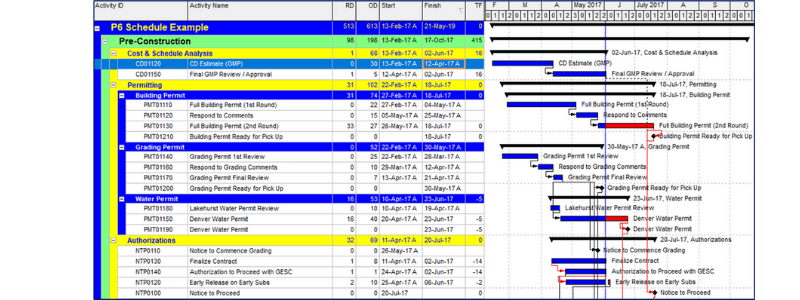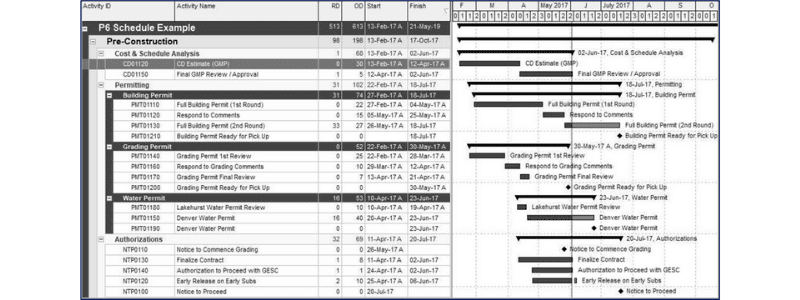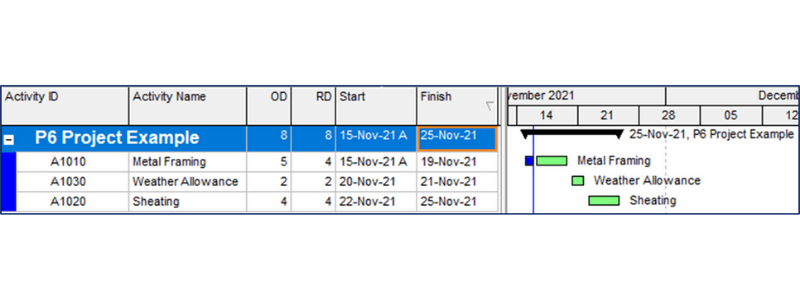In any dispute, proper documentation is an important element for supporting a position – and this is especially true in matters involving project delays. When a dispute arises over project delays, contemporaneous records and schedule updates are key documents for establishing entitlement and assigning liability. Project schedule files are often relied upon in the analysis of delays and preparation of affirmative claims or defenses. The data available from the schedule files is a factor which may dictate the type of forensic schedule analysis method that can be utilized.
One important consideration is the format in which schedule files are available. Schedules are commonly shared with project participants as a Portable Document Format (PDF), which can be opened on most computers, rather than the native file format which is opened in the software in which the schedule was generated. While PDFs are usually adequate for planning the actual work or reporting construction progress, they may not provide enough information to allow for a comprehensive delay analysis, particularly on intricate construction projects with complex activity relationships. In this article, we discuss what differentiates native and non-native schedules, and the role native schedules play in the preparation and analysis of construction delay claims.
What is a project schedule? What is a “native” file?
A project schedule is a general term for a planning tool that forecasts the anticipated performance dates of the various activities required to complete the project scope. Typically created by the prime contractor or construction manager, the project schedule serves as a roadmap to complete the work and depicts the means and methods of construction by presenting the relationship between activities (known as logic) and the duration of each activity. Depending on the level of detail and the requirements identified in the specifications, schedules may also identify anticipated resource allocations, required resources and cost value of activities. Activities of various durations linked by relationships depict the steps necessary to achieve forecasted milestone and completion dates. Visually, schedules are commonly presented as a time-scaled bar chart – commonly referred to as a Gantt chart.
An example subset of preconstruction activities from a project schedule, where lines between activity bars represent relationships between activities, can be seen in Figure 1.

All but the simplest construction projects require the use of Critical Path Method (CPM) scheduling techniques. CPM schedules are generated in a variety of scheduling software suites – most commonly Oracle Primavera or Microsoft Project (generally used for less complex schedules). Like other software, Primavera and Microsoft Project read and write to specific file extensions. For Microsoft Project, schedule files are saved like Word or Excel documents, but produced with the file extension .MPP. As Primavera is a database software, a schedule prepared in Primavera does not generate a local copy until the data is exported. When exported, the file type for Primavera files is .XER. Other formats, such as .XML and .XLS can also be utilized by Primavera or Microsoft Project.
In Figure 1, the data columns of the schedule identify the
- Activity ID
- Activity name
- Activity duration (both the original duration (OD), and remaining duration (RD) to complete)
- Start date
- Finish date
- Total float (TF).[1]
Within the scheduling software, these columns can be customized to provide hundreds of different options, including lists of predecessors or successors, percent complete, total float, float path order and much more. The Gantt chart in this example identifies critical path activities with a red bar, and certain schedule logic as lines between activities.[2], [3]
While critical activities are commonly presented as red bars, the bar colors can be customized as well, so their meaning should be confirmed within the legend that is often provided in the footer of the schedule print-out, or within the native file. Because of the volume of information contained within a schedule file, and because the party printing a schedule as a PDF determines which information will be shared, certain information contained within a native file may not be ascertainable from a non-native file alone.
Non-native Schedule Files: Challenges for Forensic Analysis
In many cases, not all stakeholders have access to specialized scheduling software, which can be costly, and as such, schedules are commonly transmitted as non-native PDF files. While these files are typically readable and sharable on most computers, PDF files do not capture all the data contained within the native schedule file. Oftentimes, a PDF of a project schedule in conjunction with a schedule narrative is adequate for:
- Tracking schedule progress and variances,
- Understanding changes made to a schedule and
- Planning remaining work.
It is important to note that the information presented in a PDF is subject to the contract requirements that dictate what needs to be presented and the discretion of the company or person who prepares the schedule. This can result in the exclusion of certain data, such as float values, which could be helpful for evaluating delays. This can make schedule analysis challenging (or even impossible), and during construction, lack of schedule transparency may cause contractors to accelerate or compress work without realizing they are doing so because of changes to activities implemented by the scheduler that are not readily apparent without evaluating the native file.

As shown in Figure 2, a non-native PDF schedule may only provide a list of project activities with durations, start dates and finish dates. Unlike Figure 1, relationship lines are not provided, and without color, activity status cannot be determined.
In simple schedules, a competent analyst may be able to assume the underling logic between activities with a reasonable degree of certainty. In more complex schedules, tracing logic and identifying logic ties between activities (or other information that may not be readily discernible in a PDF, e.g. the calendars where activities are assigned) can become increasingly difficult. This may affect the ability to perform a critical path analysis and the accuracy of observations about the effects of a delay. Consequently, a schedule analyst may be unable to perform an accurate forensic schedule analysis with data from certain non-native schedules.
Some of the information that may not be conveyed in a non-native file include:
Data date
The data date reflects the date to which the schedule has been updated. In Figure 1, the vertical blue line in the Gantt chart visually represented the data date; but the exact date cannot be precisely ascertained. While data dates are often provided in the legend, they may be excluded.
Activity relationships
Even when predecessors / successors are identified, or relationship lines are graphically provided, the relationship between activities can still be uncertain, as activities can be linked by various methods (Finish-Start, Finish-Finish, Start-Finish, Start-Start), and contain either leads or lags which further define and adjust the relationship.[4]
Constraints
While activity constraints are often indicated with an asterisk next to the activity start or finish date (provided those are visible), the constraint which is being applied, such as a “Start on”, “Start on or After,” “Finish on or Before,” etc. may not be identifiable.
Critical or longest path
Even when a full-color non-native schedule is produced with a legend identifying critical activities, the non-native file can be misleading, as the scheduler may define critical activities as the longest path, or as any activity with Total Float that is less than a certain value.
Activity calendars
Scheduling software allows for the implementation of global and activity calendars. Without access to the native files, it may be difficult to determine specific holiday or shutdown considerations contemplated for the project, or if specific activities are on certain calendars. For example, some work may be on a 6-day or 7-day calendar, or paving work on a road project may be on a calendar that does not plan for the activity to be performed between November and May.
Figure 3 and Figure 4 illustrates how different activities can have multiple logic configurations or calendar assignments, which may not be identifiable with a non-native file. Metal framing and sheathing may both be on 5-day calendars, with finish-start relationship between the activities, and no link to the weather allowance activity. Alternately, all activities can be on a 7-day calendar where there is a finish-start relationship with a 2-day lag between framing and sheathing. Or the activities can be on a 7-day calendar where the weather allowance activity has a relationship between the framing and sheathing activities. Without a native schedule, the true logic may need to be assumed, since different configurations of data input can depict the same output.

| Duration | Start Date | Finish Date | |
| Metal Framing | 5 | Mon, November 15, 2021 | Fri, November 19, 2021 |
| Sheathing | 4 | Mon, November 22, 2021 | Thu, November 25, 2021 |
| Weather Allow. | 2 | Sat, November 20, 2021 | Sun, November 21, 2021 |
Native Schedules: All the Data That’s Fit to Print
The native schedule provides the necessary data to avoid or limit assumptions.
Native schedules provide more avenues for analysis, as they do not need to be reproduced in scheduling software like non-native files in order to model impacts and effects on the schedule or identify impacts and changes between schedule updates. For reconstruction of a computerized CPM model from a hardcopy, the Association for the Advancement of Cost Engineering (AACE) recommends that the hardcopy include:
- Predecessor and successor listing with logic type and lag duration, preferably sorted by activity ID
- Tabular listing of activities showing duration
- Calendar ID
- Early and late dates, preferably sorted by activity ID
- A detailed listing of working days for each calendar used [5]
While AACE Recommended Practice 29R-03 indicates that “a graphic logic diagram alone is not a reliable hardcopy source to reconstruct an accurate copy of a schedule,” for reasons noted herein, workable models may be created without all the recommended data indicated above.
The information readily available in native files, which may not be discernible in a non-native format, and the ability to analyze these files through adjustments, is a key reason why it is important to obtain native schedules. When a native schedule is provided, the schedule analyst can perform a wide range of tasks without reconstructing the schedule data, such as:
- Filter, organize, and analyze the data within schedules quickly and efficiently.
- Perform certain forensic delay analyses, such as a Time Impact Analysis (“TIA”) or Collapsed As-Built, which involve modification to schedules in order to understand how delaying events affect the project.
- Display side-by-side comparisons of a baseline schedule to a current schedule.
- View schedule logs that show logic changes, late start and finish, out-of-sequence activities, duration changes, activities without predecessors and successors, constraints, and other metrics.
In summary, native schedules allow the schedule analyst to understand fully the sequence of construction, the interaction between activities and schedule impacts. Native files allow for analysis with significantly less effort, and with less likelihood of relying on assumptions that may be necessary when only non-native schedule files are provided. However, native schedule files are often just a part of the documents needed to perform a forensic schedule analysis, as other project documents and information may be needed to validate the schedule data and understand delay causation.
Vertex recommends that any party who receives a schedule for use on a construction project request a copy of the file in its native format, even if they do not have the software to open the file for document retention purposes and in the event these files are later required for a claim or delay analysis. In any type of delay dispute, Vertex recommends that project schedules always be requested in their native format as part of a document request or formal request for production. If a non-native (PDF) of a schedule is provided, then a native version of that schedule presumably exists if proper document controls were maintained and should be made available or should be obtainable through the project record.
If you need assistance in preparing or defending a construction delay claim, please contact Jeff Katz or Andrew Sargent or call 888.298.5162 or submit an inquiry.
[1] Total Float is the amount of time that an activity can be delayed without delaying the project finish date.
[2] Critical Path is the longest continuous chain of activities which establishes the minimum overall project duration.
[3] Schedule activities are connected by schedule logic – predecessor and successors. The activities that precede an activity in a logic sequence are called predecessors. The activities that come after an activity in a logic sequence are called successors.
[4] Lag time is a duration that is added to a relationship link to impose a wait time between an activity and its successor. If the lag is a positive duration, then the successor activity will have a wait period before staring. If the lag is negative duration (also called a lead or lead time), then the successor will overlap the predecessor activity.
[5] AACE Recommended Practice 29R-03





